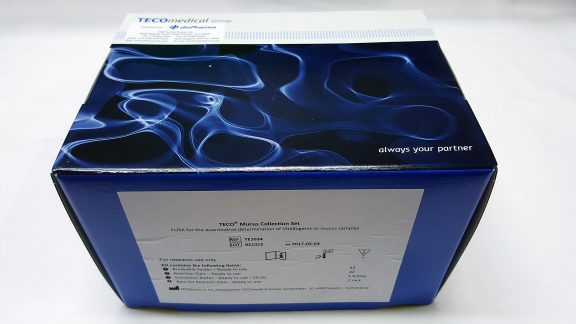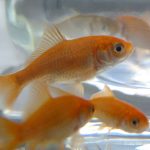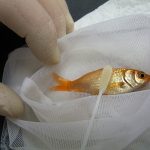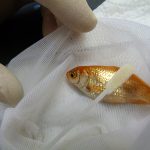
TECO® Mucus Collection Set
$0.00
The TECO® Mucus Collection Set is a collection set for fish mucus, including validated swabs, sample tubes in a sample tube rack, a specifically designed extraction buffer and a kit instruction. The Mucus Collection Set is a validated tool for repeatable non-invasive/non-destructive sampling of epidermal mucosa for vitellogen determination.
The TECO® Mucus Collection Set for fish mucus is a validated tool for repeatable non-destructive sampling of epidermal mucosa for vitellogenin determination using the:
- TECO® Perch (Perciformes) Vitellogenin ELISA Kit, TE1035
- TECO® Cyprinid Vitellogenin ELISA Kit, TE1037
Components are ready to use.
| Breakable Swabs | 42. Ready to use. |
|---|---|
| Reaction Vials | 42. Ready to use. |
| Extraction Buffer | 1 x 25 ml Ready to use. |
| Rack for Reaction Vials | 1 x |
| Kit instruction | 1 x |
Is there an ultrasensitive Perch ELISA available? Are there any suggestions for modifying the Perch ELISA if lower VTG values need to be detected in mucus?
The TECO® Perch Vitellogenin ELISA is the only commercially available ELISA for Perch/Perciformes. At the moment, there is not enough demand for an ultra-sensitive protocol. One option using the current protocol is to lower the dilution factor from 1:10 (50μL sample + 450μL extraction buffer) to 1:6 (50μL sample + 250μL extraction buffer). In development, this has been shown to increase the sensitivity of the assay appropriately.
How do I know mucus samples are not cross-contaminated by a nearby fish when I am collecting my samples?
It is recommended that mucus under the gill be swabbed, if cross contamination from nearby fish is a concern. This can be a concern with net fishing, where high- and low- level vitellogenin fish are in close proximity to each other.
How do I know mucus samples are not cross-contaminated with other environmental substances that may interfere with the assay and affect my results?
The antibodies used in the assays are very specific and do not recognize other components. Furthermore, the extraction buffer (500μL) used to dilute the mucus collected with the swab has a dilution effect that will dilute out a rare occurrence of an environmental contaminant. In development of the assay, aquarium water was used as a negative control and no contamination from the mucus samples was detected in comparison to the aquarium water.
Is it necessary to correct mucus (or blood, WBH) VTG against the protein alone?
While this is not necessary, the extraction buffer used in collecting mucus and the dilution buffer used in diluting blood and WBH are protein-free so they do allow for an easy parallel determination of proteins.
What is the calibrator material?
The calibrator material is biologic and not recombinant. It is prepared from serum that has been run through a column and separated via affinity chromatography. It is extensively validated and characterized using immunohistochemical staining, Western blot and SDS PAGE technology.
What is the composition of the matrix solution and what is its purpose in the assay?
The exact composition is proprietary information. The solution is responsible for activating the full reactivity of the plates.
What is the composition of mucus extraction buffer and sample dilution buffer?
The exact composition is proprietary information but both are protein-free solutions optimized for the assay.
What are the test strips coated with?
A polyclonal (affinity purified) antibody to vitellogenin.
What dilution should be used to prepare samples?
The best sample dilution will vary based on type of sample (blood, homogenate or mucus), species and exposure to test compound(s). Refer to the package insert and/or the Vitellogenin ELISA Crossreactivity chart for suggested dilution ranges. During assay evaluation/validation, it is recommended that several dilutions, based on the recommended range, be tested initially using a subgroup of samples. The results from assaying the subgroup at several dilutions can then be used to determine the best dilution for the rest of your samples based on your experimental design.
Can serum or plasma samples be used in the ELISA?
Yes, in all assays. Homogenate epidermal mucus samples may also be used.
What are the advantages of performing ELISA rather than molecular testing?
Molecular testing reflects the gene expression whereas ELISA assays detect the product, or actual effect, of this expression. Additionally, molecular assays tend to be time-consuming, costly and more sensitive to technique variables such that they require special laboratories with well-trained personnel.
How soon after exposure will the VTG protein be detected in mucus compared to blood/homogenate and compared to the detection of vtg gene expression?
This will vary depending on the substance and species, but in general, the VTG protein (gene expression) can be detected in mucus 48 hours after exposure to 2.5 ng/L EE2.
What are the advantages of using mucus rather than blood or whole body homogenate?
Mucus collection is non-invasive and non-destructive. It can be easier to collect from smaller fish. Collectingmucus does not require sacrificing the fish which means repeat sampling allows for studying induction kineticsby individual. Repeat sampling also allows for pre-exposure testing, making it possible to assess handling(stress)-related impacts on VTG induction. Additionally, research indicates the vitellogenin protein may be morestable in mucus. In blood, the vitellogenin protein can be especially prone to proteolytic cleavage.
Background
Vitellogenin (VTG) is one of the core endpoints in screening and testing for endocrine disrupting chemicals standardized in the OECD Guidelines for the testing of chemicals for estrogenic activity. Originally believed to be produced only in the liver, several cell types have recently been shown to produce VTG after estrogen stimulation, including those of the epidermal mucosa of fish.
Given the destructive nature of traditional sampling, collecting successive samples from fish has been a widespread problem, as for instance in the analysis of vitellogenin induction while screening and testing chemical substances for endocrine disruption potential. Blood is difficult to collect, in particular where very small fish are concerned, or in approaches where the animals must survive sampling. This is particularly important in field monitoring in order to avoid impact on the population under investigation.
Even though the VTG concentration in the skin mucus is an order of magnitude lower than in blood serum or in body homogenates (containing liver tissue), the skin mucosa is very well suited as a matrix to determine exogenous VTG induction caused by environmental chemicals with affinity to the estrogen receptors. Mucus sampling with the aid of swabs constitutes an alternative to traditional procedures, avoiding animal injury by using a highly sensitive ELISA in combination with a high quality extraction buffer and swab sampling, the determination of mucosa-derived VTG has the following advantages:
- Non-destructive, non-invasive sampling
- Defined matrix without lymphatic fluid contamination
- Allows the use of smaller fish for testing and monitoring purposes
- Repeated sampling allows for individual recording of the induction kinetic
The sampling technique leads to highly comparable results when testing samples from the left and the right side from the same individual in inter-laboratory trials.



